width Citroen GRAND C4 PICASSO RHD 2016 2.G Owner's Manual
[x] Cancel search | Manufacturer: CITROEN, Model Year: 2016, Model line: GRAND C4 PICASSO RHD, Model: Citroen GRAND C4 PICASSO RHD 2016 2.GPages: 523, PDF Size: 13.63 MB
Page 84 of 523
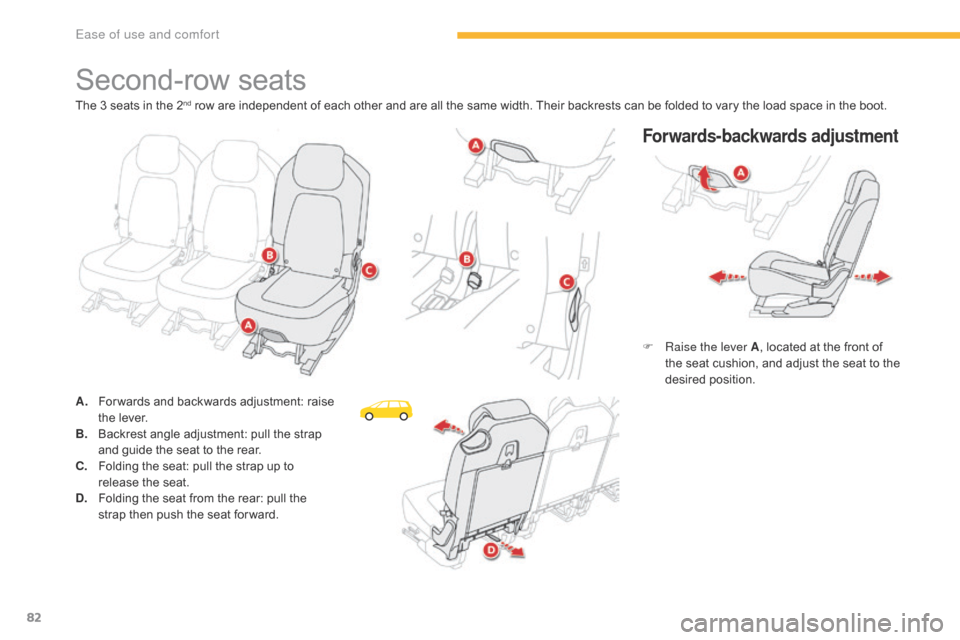
82
Second-row seats
Forwards-backwards adjustment
F Raise the lever A , located at the front of t
he seat cushion, and adjust the seat to the
de
sired
p
osition.
The
3
seats
in
the
2
nd row are independent of each other and are all the same width. Their backrests can be folded to vary the load space in the boot.
A.
F
or wards
and
backwards adjustment: raise
t
he
lever.
B.
B
ackrest
angle
adjustment: pull the strap
a
nd
guide
the
seat to the rear.
C.
F
olding
the
seat:
pull the strap up to
r
elease
t
he
sea
t.
D.
F
olding
the
seat
from the rear: pull the
s
trap
then
push
the seat for ward.
Ease of use and comfort
Page 165 of 523
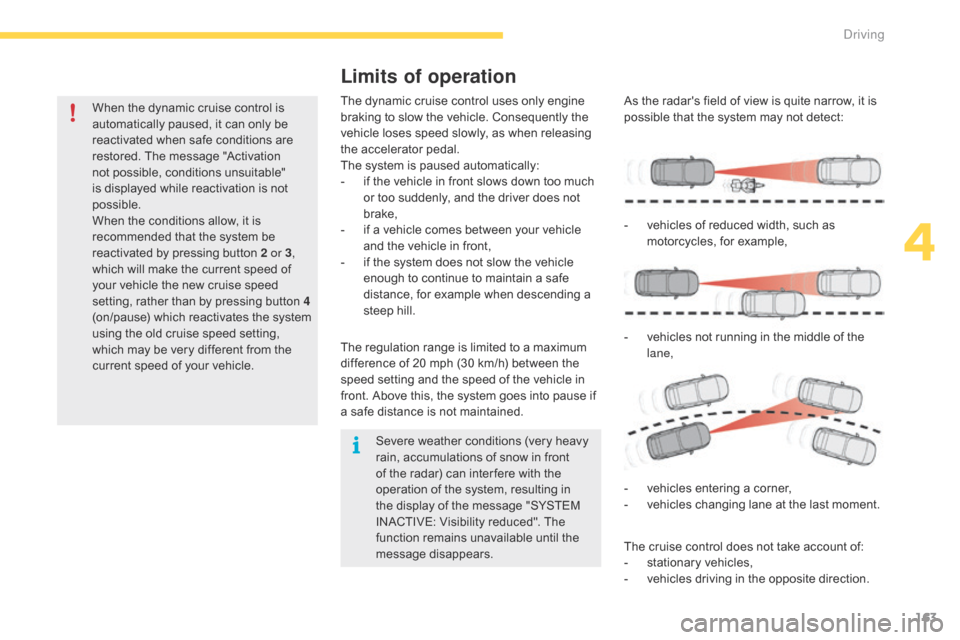
163
When the dynamic cruise control is automatically paused, it can only be
r
eactivated when safe conditions are
r
estored. The message "Activation
n
ot possible, conditions unsuitable"
i
s displayed while reactivation is not
p
ossible.
When
the conditions allow, it is
r
ecommended that the system be
r
eactivated by pressing button 2 or 3,
which
will make the current speed of
y
our vehicle the new cruise speed
s
etting, rather than by pressing button 4
(on/pause)
which reactivates the system
u
sing the old cruise speed setting,
w
hich may be very different from the
c
urrent speed of your vehicle. The
dynamic cruise control uses only engine b
raking to slow the vehicle. Consequently the
v
ehicle loses speed slowly, as when releasing
t
he accelerator pedal.
The
system is paused automatically:
-
i
f the vehicle in front slows down too much
o
r too suddenly, and the driver does not
b
rake,
-
i
f a vehicle comes between your vehicle
a
nd the vehicle in front,
-
i
f the system does not slow the vehicle
e
nough to continue to maintain a safe
d
istance, for example when descending a
s
teep hill.
Limits of operation
As the radar's field of view is quite narrow, it is possible that the system may not detect:
The
cruise control does not take account of:
-
s
tationary vehicles,
-
v
ehicles driving in the opposite direction.
-
v
ehicles of reduced width, such as
m
otorcycles, for example,
-
v
ehicles not running in the middle of the
lan
e,
-
v
ehicles entering a corner,
-
v
ehicles changing lane at the last moment.
The
regulation
range
is
limited
to
a
maximum
d
ifference
of
20
mph
(30
km/h)
between
the
s
peed
setting
and
the
speed
of
the
vehicle
in
f
ront.
Above
this,
the
system
goes
into
pause
if
a
safe
distance
is
not
maintained.
Severe
weather
conditions
(very
heavy
r
ain,
accumulations
of
snow
in
front
o
f
the
radar)
can
inter fere
with
the
o
peration
of
the
system,
resulting
in
t
he
display
of
the
message
"SYSTEM
I
NACTIVE:
Visibility
reduced".
The
f
unction
remains
unavailable
until
the
m
essage
d
isappears.
4
Driving
Page 174 of 523
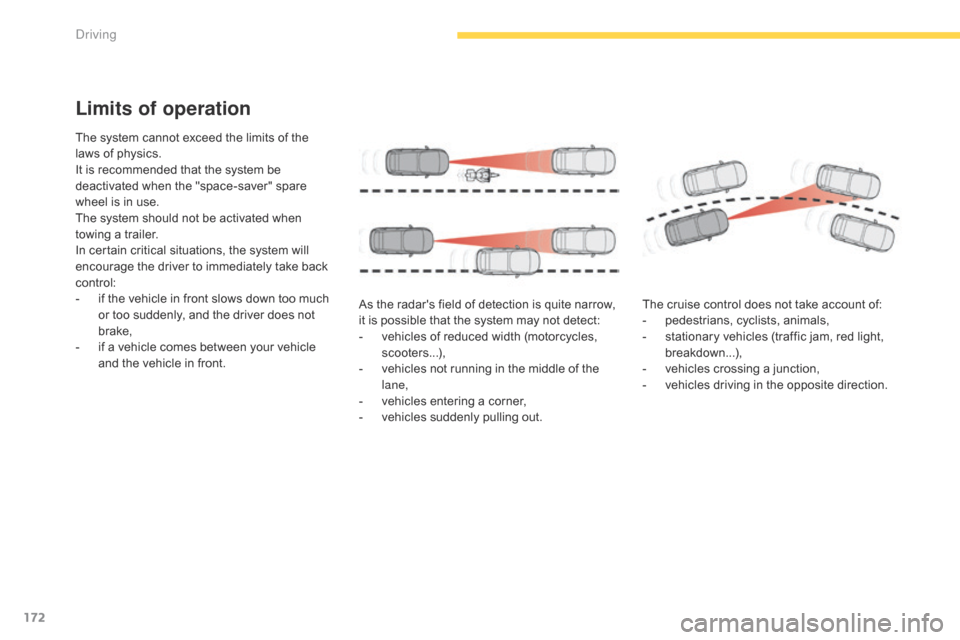
172
Limits of operation
The system cannot exceed the limits of the laws of physics.
It
is recommended that the system be
d
eactivated when the "space-saver" spare
w
heel is in use.
The
system should not be activated when
t
owing a trailer.
In
certain critical situations, the system will
e
ncourage the driver to immediately take back
c
ontrol:
-
i
f the vehicle in front slows down too much
o
r too suddenly, and the driver does not
b
rake,
-
i
f a vehicle comes between your vehicle
a
nd the vehicle in front. As
the radar's field of detection is quite narrow,
i
t is possible that the system may not detect:
-
v
ehicles of reduced width (motorcycles,
s
cooters...),
-
v
ehicles not running in the middle of the
lan
e,
-
v
ehicles entering a corner,
-
v
ehicles suddenly pulling out.The
cruise control does not take account of:
-
p
edestrians, cyclists, animals,
-
s
tationary vehicles (traffic jam, red light,
b
reakdown...),
-
v
ehicles crossing a junction,
-
v
ehicles driving in the opposite direction.
Driving
Page 189 of 523
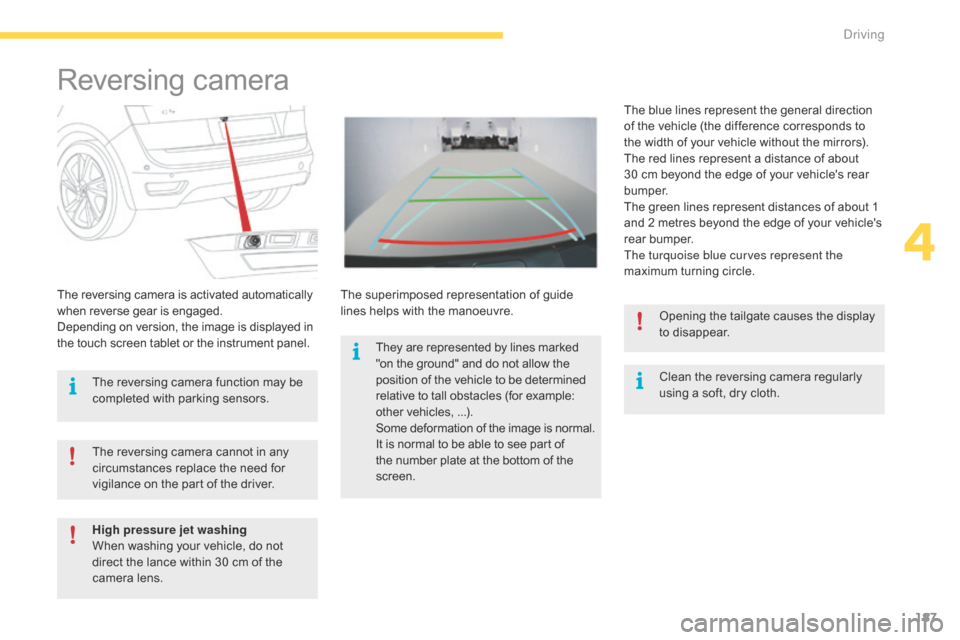
187
Reversing camera
Clean the reversing camera regularly u
sing a soft, dry cloth.
The
reversing
camera
is
activated
automatically
w
hen
r
everse
g
ear
i
s
enga
ged.
Depending
on
version,
the
image
is
displayed
in
t
he
touch
screen
tablet
or
the
instrument
panel. The
superimposed
representation
of
guide
l
ines
helps
with
the
manoeuvre. The
blue lines represent the general direction
o
f
the
vehicle (the difference corresponds to
t
he
width of your vehicle without the mirrors).
The
red lines represent a distance of about
3
0
cm
beyond the edge of your vehicle's rear
b
u m p e r.
The
green lines represent distances of about 1
a
nd
2
metres beyond the edge of your vehicle's
r
ear
bumper.
The turquoise blue curves represent the
maximum turning circle.
The
reversing
camera
cannot
in
any
c
ircumstances
replace
the
need
for
v
igilance
on
the
part
of
the
driver. Opening
the tailgate causes the display
t
o disappear.
The
reversing
camera
function
may
be
c
ompleted
with
parking
sensors.
High pressure jet washing
When
washing
your
vehicle,
do
not
d
irect
the
lance
within
30
cm
of
the
c
amera
lens. They
are
represented
by
lines
marked
"
on
the
ground"
and
do
not
allow
the p
osition
of
the
vehicle
to
be
determined r
elative
to
tall
obstacles
(for
example:
o
ther
vehicles, ...).
Some
d
eformation
o
f
t
he
i
mage
i
s
n
ormal.
It
is
normal
to
be
able
to
see
part
of
t
he
number
plate
at
the
bottom
of
the
sc
reen.
4
Driving
Page 190 of 523
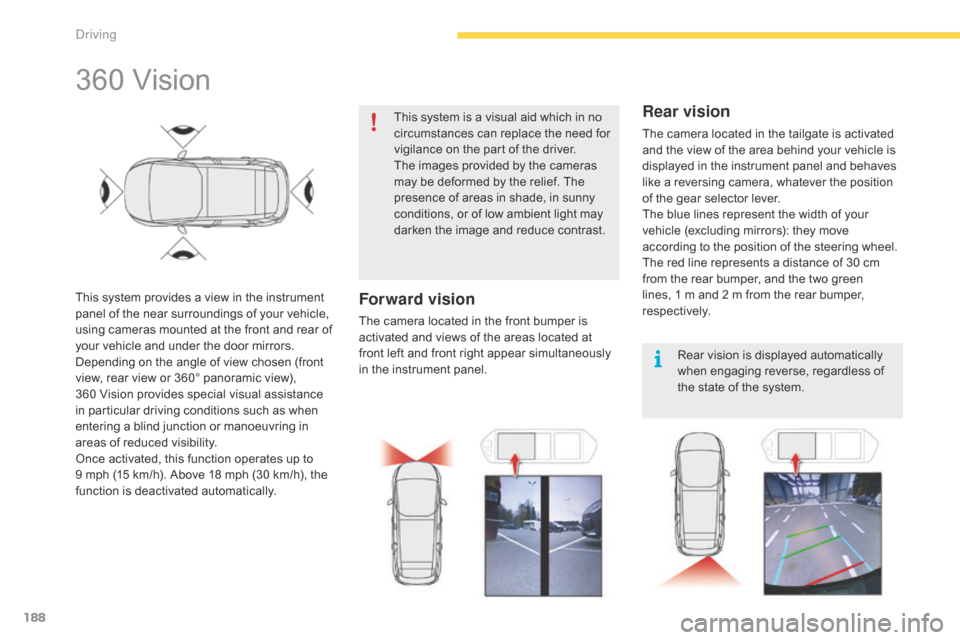
188
360 Vision
This system provides a view in the instrument panel of the near surroundings of your vehicle,
u
sing cameras mounted at the front and rear of
y
our vehicle and under the door mirrors.
Depending
on the angle of view chosen (front
v
iew, rear view or 360° panoramic view),
3
60 Vision provides special visual assistance
i
n particular driving conditions such as when
e
ntering a blind junction or manoeuvring in
a
reas of reduced visibility.
Once
activated, this function operates up to
9 m
ph (15 km/h). Above 18 mph (30 km/h), the
f
unction is deactivated automatically. This
system is a visual aid which in no
c
ircumstances can replace the need for
v
igilance on the part of the driver.
The images provided by the cameras
m
ay be deformed by the relief. The
p
resence of areas in shade, in sunny
c
onditions, or of low ambient light may
d
arken the image and reduce contrast.Forward vision
The camera located in the front bumper is a
ctivated and views of the areas located at
f
ront left and front right appear simultaneously
i
n the instrument panel.
Rear vision
The camera located in the tailgate is activated and the view of the area behind your vehicle is
d
isplayed in the instrument panel and behaves
l
ike a reversing camera, whatever the position
o
f the gear selector lever.
The
blue lines represent the width of your
v
ehicle (excluding mirrors): they move
a
ccording to the position of the steering wheel.
The
red line represents a distance of 30 cm
f
rom the rear bumper, and the two green
l
ines, 1 m and 2 m from the rear bumper,
r
espectively. Rear
vision is displayed automatically
w
hen engaging reverse, regardless of
t
he state of the system.
Driving
Page 251 of 523
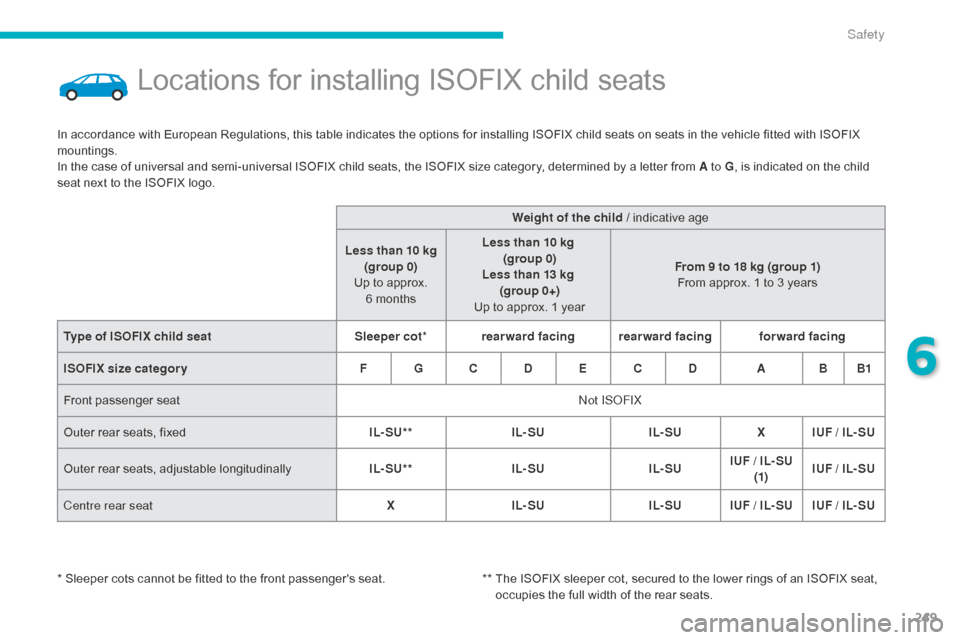
249
Locations for installing ISOFIX child seats
In accordance with European Regulations, this table indicates the options for installing ISOFIX child seats on seats in the vehicle fitted with ISOFIX mountings.
In
the case of universal and semi-universal ISOFIX child seats, the ISOFIX size category, determined by a letter from A to G,
is indicated on the child
s
eat next to the ISOFIX logo. Weight of the child
/ indicative age
Less than 10 kg (group 0)
Up
to approx.
6 m
onthsLess than 10 kg
(group 0)
Less than 13 kg (group 0+)
Up to approx. 1 yearFrom 9 to 18 kg (group 1)
From
approx. 1 to 3 years
Type of ISOFIX child seat Sleeper cot*rearward facing rearward facing forward facing
ISOFIX size categor y F G C D E C D A B B1
Front
p
assenger
sea
t Not ISOFIX
Outer
rear seats, fixed IL- SU**IL- SUIL- SUX IUF / IL- SU
Outer
r
ear
s
eats,
a
djustable
l
ongitudinallyIL- SU**IL- SUIL- SUIUF / IL- SU
(1) IUF / IL- SU
Centre rear seat XIL- SU IL- SUIUF / IL- SU IUF / IL- SU
*
S
leeper cots cannot be fitted to the front passenger's seat. **
T
he ISOFIX sleeper cot, secured to the lower rings of an ISOFIX seat,
o
ccupies the full width of the rear seats.
6
Safety
Page 253 of 523

251
Locations for installing ISOFIX child seats
In accordance with European Regulations, this table indicates the options for installing ISOFIX child seats on seats in the vehicle fitted with ISOFIX mountings.
In
the case of universal and semi-universal ISOFIX child seats, the ISOFIX size category, determined by a letter from A to G,
is indicated on the child
s
eat next to the ISOFIX logo.
*
Sleeper cots cannot be fitted to the front passenger's seat.**
A
n ISOFIX sleeper cot, secured to the lower rings of an ISOFIX seat,
o
ccupies the full width of the rear seats.
Weight of the child
/ indicative age
Less than 10 kg (group 0)
Up
to approx.
6 m
onthsLess than 10 kg
(group 0)
Less than 13 kg (group 0+)
Up
to approx. 1 yearFrom 9 to 18 kg (group 1)
From
approx. 1 to 3 years
Type of ISOFIX child seat Sleeper cot*rearward facing rearward facing forward facing
ISOFIX size categor y F G C D E C D A B B1
Front
p
assenger
sea
t Not ISOFIX
Outer
rear seats, fixed IL- SU**IL- SUIL- SUIUF / IL- SU IUF / IL- SU
Outer
r
ear
s
eats,
a
djustable
l
ongitudinallyIL- SU**IL- SUIL- SUIUF / IL- SU IUF / IL- SU
Centre rear seat XIL- SU IL- SUIUF / IL- SU IUF / IL- SU
Rear
seat in the 3
rd row Not ISOFIX
6
Safety